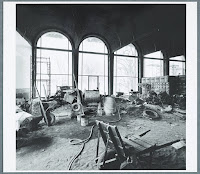They were all alphabet books, or abecedaries, that began with an apple pie and ran through all the letters until the pie was eaten. To my surprise, the "Apple Pie ABC" is actually a famous nursery rhyme. The first version of the rhyme was published in the late-eighteenth century in England and became wildly popular in English-speaking countries by the nineteenth century.
 One of the earliest versions in our collection comes in the form of a miniature chapbook. The final few pages are dedicated to "the Tragical Death of an APPLE-PYE." Rather dramatic, though I later realized that it would indeed be a tragedy from the pie's point of view.
One of the earliest versions in our collection comes in the form of a miniature chapbook. The final few pages are dedicated to "the Tragical Death of an APPLE-PYE." Rather dramatic, though I later realized that it would indeed be a tragedy from the pie's point of view.In this rhyme, all the letters in the alphabet want to eat a single apple pie, but unless they establish an order, there won't be any pie for some of the less-greedy letters. Curiously enough, the rhyme includes "&" as the final letter, for a total of 27 letters, unlike the 26 we think of today.
To read more about the tragic demise of the apple "pye," ask for Miniature 147. We have several versions of Kate Greenaway's book, including a first edition and a 1978 reprint, demonstrating the rhyme's enduring popularity.



